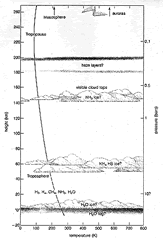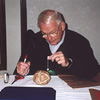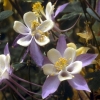This is a diagram showing the locations of the cloud decks of Saturn.
Click on image for full size
Saturn Cloud Decks
There are three regions in Saturn's atmosphere, as shown in this picture, where clouds of a particular kind, or clouddecks, are to be found. There is a clouddeck of ammonia clouds, a clouddeck of ammonia hydrosulfide clouds, and a clouddeck of water clouds (H2O).
The location of the clouds is predicted based upon the temperature at which vapor will condense into droplets. The temperature at which the condensation occurs, according to the temperature profile shown in the figure by the black line, is where the clouds ought to be.
The diagram shows that the temperature in the troposphere goes from about -300 degrees (100 K) to about +80 degrees (300 K).
The first clouddeck, made of ammonia clouds is found at about 100 km below the tropopause, where the temperature becomes about 150 K. The second clouddeck, made of ammonium hydrosulfide clouds is found at about 170 km below the tropopause, where the temperature becomes about 200 K. And the third clouddeck, made of water clouds is found at about 130 km below the tropopause, where the temperature becomes about 270 K (freezing temperature for water).
You might also be interested in:
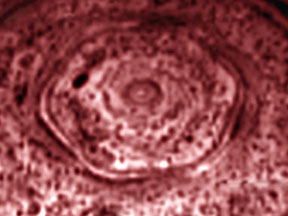
Astronomers have discovered a bizarre, hexagon-shaped feature in the clouds of Saturn near the planet's North Pole. The feature was first seen in images returned by the Voyager spacecraft in the 1980s,
...more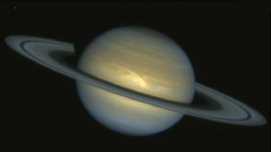
The most important motions in the atmosphere are winds. The major winds in Saturn's atmosphere are the zonal winds which are composed of alternating belts and zones flowing in opposite directions. Belts
...more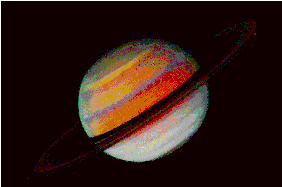
The striped cloud bands on Saturn, like Jupiter, are divided into belts and zones. In a belt, the wind flows very strongly in one direction only. In a zone, the wind flows very strongly in exactly the
...more
The position of the planets in the solar nebula greatly affected their 1. size and 2. composition. This is because of the effect of how cold it was in the nebula. 1. The nebula was a lot warmer close to
...more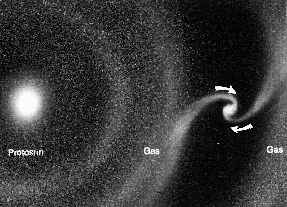
As shown in this picture, while they were forming in the solar nebula, the nucleii of the planets-to-be (called protoplanets) drew material to themselves from the cloud of gas and dust around them. The
...more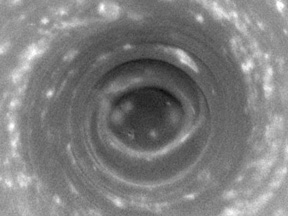
Saturn's South Pole is an extremely stormy and surprisingly warm region. A vast, hurricane-like storm centered on the South Pole dominates the area. Astonishingly, the pole is also warmer than any other
...more
Like the inner planets and Jupiter, Saturn is clearly visible in the night sky. The ancient Greeks named the planet after the god of agriculture and time. It wasn't until 1655, however, that we knew Saturn
...more


